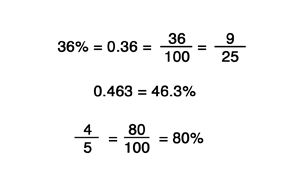Review
GRE Arithmetic - Percentages
Percent simply means 'parts per 100.' Therefore, 32% means 32 parts out of 100 and 4% means 4 parts out of 100. The notion of percent can be written in many ways. For example, the following are all equivalent:

Although the concept of percentages is often thought of as straight-forward, people who have not practiced calculating them are often prone to making errors, especially if percentages with decimal places and percentages of less than 10% are involved. For example, 9% = 0.09, and 0.9% = 0.9 out of 100, so that is 0.9/100, which is much smaller than 1%.
To change a fraction to a percent, place the percentage numbers over 100. To change a percent to a fraction, remove the percentage sign and place a decimal point two places to the right. Some examples:

Now that you know that % means out of 100, then 100% = 100/100, and 200% = 200/100, which is twice more than 100, etc. As a general rule, anything more than 100% of a number has to be more than that number.
Multiple percent increases and multiple percent decreases are not cumulative. For example, if you start with 100, and decrease it by 20%, and then decrease that by 20%, the result is NOT 60. If you do the math, you'll get: 100 - 20% = 80, and then 80 - 20% = 64. Why? Because 20% out of 100 is (100)(0.20) = 20, so 100 - 20 = 80; and 20% out of 80 = (80)(0.20) = 16, so 80 - 16 = 64! Don't get fooled with such questions, which appear often.
Multiple percent changes are not additive. You must remember this when a problem asks for you to do several percent changes in a row.